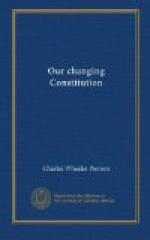Right here it may be proper to notice a new theory of construction of the Constitution, not yet accepted but strenuously urged and containing enormous potentialities. This is the “doctrine of sovereign and inherent power,” i.e., the doctrine that powers of national scope for whose exercise no express warrant is found in the Constitution are nevertheless to be implied as inherent in the very fact of sovereignty. This is a very different thing from the famous doctrine of implied powers developed by Chief Justice Marshall—that all powers will be implied which are suitable for carrying into effect any power expressly granted. It is a favorite theory of what may be termed the Roosevelt school. They consider that it is rendered necessary by the discovery of fields suitable for legislative cultivation, lying outside the domain of state power but not within the scope of any express grant of power to the nation. As practical men they abhor the existence of such a constitutional no man’s land as nature abhors a vacuum.
During the presidency of Mr. Roosevelt a determined effort was made by the representatives of the Administration[1] to secure the recognition by the Supreme Court of the doctrine of sovereign and inherent power. It was claimed in the brief filed by the Attorney General and Solicitor General that the doctrine had already been applied by the Court in the Legal Tender cases.[2] The effort failed, however, the Court declaring that any such power, if necessary to the nation, must be conferred through constitutional amendment by the people, to whom all powers not granted had been expressly reserved by the Tenth Amendment.
[Footnote 1: In Kansas v. Colorado, 206 U.S., 46.]
[Footnote 2: Bryce makes a statement to the same effect. “The American Commonwealth,” Vol. I, p. 383.]
A method by which the federal power and jurisdiction have been much extended has been the occupation by Congress, through legislation of an exclusive character, of fields where the states had exercised a concurrent jurisdiction. A familiar example is found in federal bankruptcy laws. Another and striking example is the so-called “Carmack Amendment” of the federal Interstate Commerce law. The question of liability for loss or damage to goods in the hands of railways and other carriers had been a fruitful field for state legislatures and state courts. The Carmack Amendment brushed away at a single stroke whole systems of state statutes and judicial decisions (in so far as they affected traffic across state lines) and substituted a uniform system under the control of the federal courts.




